The Gene Ontology (GO) is a major bioinformatics initiative to unify the representation of gene and gene product attributes across all species. More specifically, the project aims to: 1) maintain and develop its controlled vocabulary of gene and gene product attributes; 2) annotate genes and gene products, and assimilate and disseminate annotation data; and 3) provide tools for easy access to all aspects of the data provided by the project, and to enable functional interpretation of experimental data using the GO, for example via enrichment analysis. GO is part of a larger classification effort, the Open Biomedical Ontologies, being one of the Initial Candidate Members of the OBO Foundry.
The Systems Biology Markup Language (SBML) is a representation format, based on XML, for communicating and storing computational models of biological processes. It is a free and open standard with widespread software support and a community of users and developers. SBML can represent many different classes of biological phenomena, including metabolic networks, cell signaling pathways, regulatory networks, infectious diseases, and many others. It has been proposed as a standard for representing computational models in systems biology today.
Reactome is a free online database of biological pathways. It is manually curated and authored by PhD-level biologists, in collaboration with Reactome editorial staff. The content is cross-referenced to many bioinformatics databases. The rationale behind Reactome is to visually represent biological pathways in full mechanistic detail, while making the source data available in a computationally accessible format.

BioModels is a free and open-source repository for storing, exchanging and retrieving quantitative models of biological interest created in 2006. All the models in the curated section of BioModels Database have been described in peer-reviewed scientific literature.

MIRIAM is a community-level effort to standardize the annotation and curation processes of quantitative models of biological systems. It consists of a set of guidelines suitable for use with any structured format, allowing different groups to collaborate and share resulting models. Adherence to these guidelines also facilitates the sharing of software and service infrastructures built upon modeling activities.
Igor I. Goryanin is a systems biologist, who holds a Henrik Kacser Chair in Computational Systems Biology at the University of Edinburgh. He also heads the Biological Systems Unit at the Okinawa Institute of Science and Technology, Japan.
BioPAX is a RDF/OWL-based standard language to represent biological pathways at the molecular and cellular level. Its major use is to facilitate the exchange of pathway data. Pathway data captures our understanding of biological processes, but its rapid growth necessitates development of databases and computational tools to aid interpretation. However, the current fragmentation of pathway information across many databases with incompatible formats presents barriers to its effective use. BioPAX solves this problem by making pathway data substantially easier to collect, index, interpret and share. BioPAX can represent metabolic and signaling pathways, molecular and genetic interactions and gene regulation networks. BioPAX was created through a community process. Through BioPAX, millions of interactions organized into thousands of pathways across many organisms, from a growing number of sources, are available. Thus, large amounts of pathway data are available in a computable form to support visualization, analysis and biological discovery.
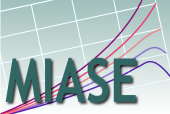
The minimum information about a simulation experiment (MIASE) is a list of the common set of information a modeller needs to enable the execution and reproduction of a numerical simulation experiment, derived from a given set of quantitative models.

The Systems Biology Graphical Notation (SBGN) is a standard graphical representation intended to foster the efficient storage, exchange and reuse of information about signaling pathways, metabolic networks, and gene regulatory networks amongst communities of biochemists, biologists, and theoreticians. The system was created over several years by a community of biochemists, modelers and computer scientists.
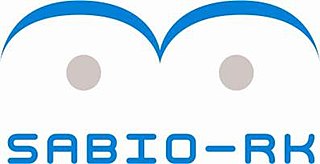
SABIO-RK is a web-accessible database storing information about biochemical reactions and their kinetic properties.
LibSBML is an open-source software library that provides an application programming interface (API) for the SBML format. The libSBML library can be embedded in a software application or used in a web servlet as part of the application or servlet's implementation of support for reading, writing, and manipulating SBML documents and data streams. The core of libSBML is written in ISO standard C++; the library provides API for many programming languages via interfaces generated with the help of SWIG.
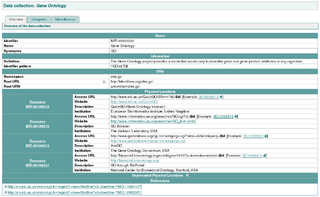
The MIRIAM Registry, a by-product of the MIRIAM Guidelines, is a database of namespaces and associated information that is used in the creation of uniform resource identifiers. It contains the set of community-approved namespaces for databases and resources serving, primarily, the biological sciences domain. These shared namespaces, when combined with 'data collection' identifiers, can be used to create globally unique identifiers for knowledge held in data repositories. For more information on the use of URIs to annotate models, see the specification of SBML Level 2 Version 2.
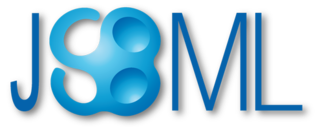
JSBML is an open-source Java (API) for the SBML format. Its API strives to attain a strong similarity to the Java binding of the corresponding library libSBML, but is entirely implemented in Java and therefore platform independent. JSBML provides an elaborated abstract type hierarchy, whose data types implement or extend many interfaces and abstract classes from the standard Java library. In this way, JSBML integrates smoothly into existing Java projects, and provides methods to read, write, evaluate, and manipulate the content of SBML documents.
Identifiers.org is a project providing stable and perennial identifiers for data records used in the Life Sciences. The identifiers are provided in the form of Uniform Resource Identifiers (URIs). It is also a resolving system that relies on collections listed in the MIRIAM Registry to provide direct access to different instances of the identified records.

The Kinetic Simulation Algorithm Ontology (KiSAO) supplies information about existing algorithms available for the simulation of systems biology models, their characterization and interrelationships. KiSAO is part of the BioModels.net project and of the COMBINE initiative.
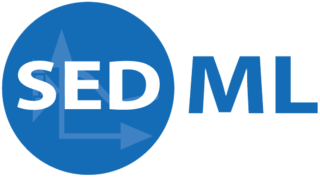
The Simulation Experiment Description Markup Language (SED-ML) is a representation format, based on XML, for the encoding and exchange of simulation descriptions on computational models of biological systems. It is a free and open community development project.

Terminology for the Description of Dynamics (TEDDY) aims to provide an ontology for dynamical behaviours, observable dynamical phenomena, and control elements of bio-models and biological systems in Systems Biology and Synthetic Biology.
Multi-state modeling of biomolecules refers to a series of techniques used to represent and compute the behaviour of biological molecules or complexes that can adopt a large number of possible functional states.
Nicolas Le Novère is a British and French biologist. His research focuses on modeling signaling pathways and developing tools to share mathematical models.










